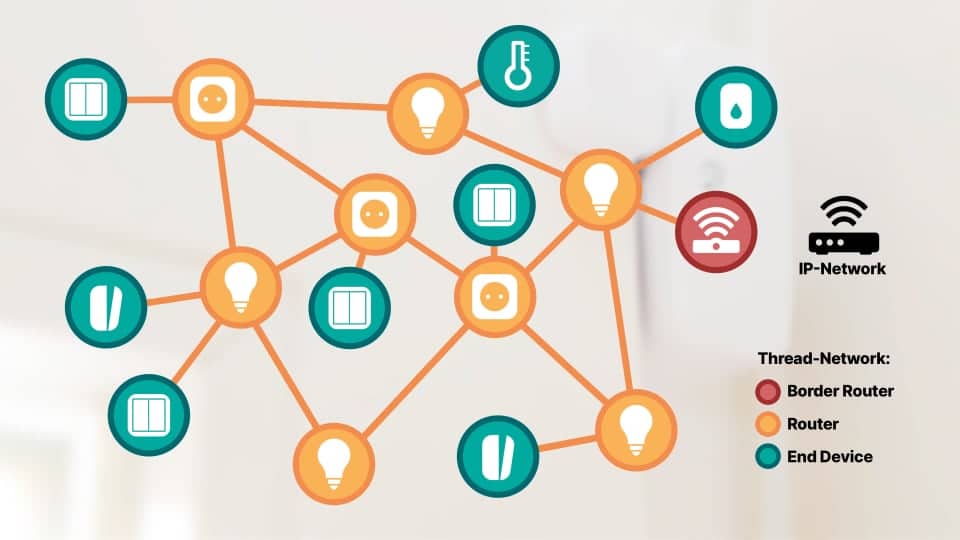#2: Thread radio protocol
As a third connection technology besides LAN (Ethernet) and WLAN (WiFi), the inventors of Matter have provided for the Thread radio protocol. It is less well-known than Z-Wave or Zigbee, but has similar advantages:
- Thread requires little energy to send and receive. This is especially beneficial for battery-powered devices such as motion detectors, radiator thermostats and door/window contacts.
- Thread is mesh-enabled. The devices establish a wireless connection with each other. Products connected to the power line, such as lamps and adapter plugs, also serve as repeaters and connect more distant devices that would otherwise lose contact.
The mesh network

The term mesh refers to a woven or lattice fabric. It alludes to the fact that the radio waves in the mesh network interlock like the stitches in a knitted sweater. The participants are assigned different tasks. There are three types of devices in each thread installation:
- End Devices do not have a supporting function; in a sense, they hang at the loose end of a thread. In most cases, these are battery-powered components such as smart home sensors, pushbuttons, or controllers with limited energy requirements. An End Device transmits and receives only when needed, which extends its battery life.
- Routers forward the radio signal to other devices in the Thread network. At the same time, they amplify it to extend the range. Each installed Router makes the mesh more robust and stable. In order for it to perform this task, it must be ready to transmit and receive at all times. That’s why Routers usually have a power connection. Typical representatives of this type are light sources such as LED lamps or intermediate plugs for the wall socket.
- Border Routers establish a connection to the IP network of the WLAN router. This means that Thread devices can also be reached from a smartphone – or via the Internet. There is at least one Border Router in every Thread household, but there can also be several installed. They do not interfere with each other because the network automatically puts one of them in charge. More information can be found in the article in the post What is a Thread Border Router?
The Border Router

On the surface, a Thread Border Router is similar to a bridge in other wireless systems. Philips Hue, for example, connects its Zigbee network to the router’s IP network via a bridge. Ikea has its Trådfri gateway for this purpose. In practice, however, there is a difference: the Border functionality is being integrated into other Thread-enabled devices. This eliminates the need to install a standalone wireless bridge.
Some manufacturers have already started – or at least announced – to make their products usable as Border Routers:
- Amazon has made its 4th generation Echo Thread-enabled via a software update. Thus, it is also suitable as a border router that can establish a connection between installed Thread products and the home network.
- Apple equips its HomePod mini, the 2nd generation HomePod (2023) and its Apple TV 4K since the 3rd generation (2021) accordingly. They can serve as Border Routers for HomeKit and now also for Matter devices.
- Eero integrates border functionality into its Eero Pro, Eero 6 and Eero 6 Pro Wi-Fi mesh systems. Starting with operating system version 3.7.0, Thread can be activated in the settings of the Eero app.
- Google declared its 2nd generation Nest Hub, Nest Hub Max and its Nest WiFi mesh system to be border routers. Corresponding software updates were rolled out in December 2022.
- Nanoleaf equips its Elements, Lines and Shapes product ranges with a border function. The Wi-Fi controllers of the light panels and LED elements are to establish contact with the home network in the future (link).
As Thread products become more widespread, the number of Border Routers will also continue to grow. Theoretically, the function can be installed in all kinds of devices – from wireless lamps to smart home control centers to Wi-Fi routers. Optimists expect that at some point every household will have at least one such device. This would make Thread networks as natural as Wi-Fi – ideal conditions for installing Matter devices.
Commissioning via Bluetooth

Via a border router, devices in the Thread network are accessible from the smartphone and can be configured via app. However, there is a second way to install and commission them. The Thread standard uses the Bluetooth wireless protocol for this purpose.
Products such as lamps or adapter plugs can be equipped with a dual radio chip that can handle both standards: Bluetooth and Thread. The smartphone then establishes a connection via the common Bluetooth protocol. It configures the new device and adds it to an existing Thread network. If there is no such network yet, the smartphone also serves as a gateway to the Internet, for instance to download and install new firmware.
After installation, a border router takes over these tasks. The thread network manages itself and requires no further attention. If individual nodes fail, others in the mesh take over their function. In a sense, the network heals itself and automatically closes any gaps that arise.
Share this information:

